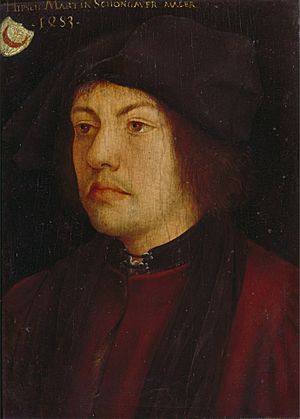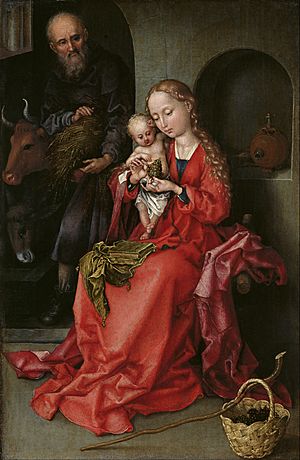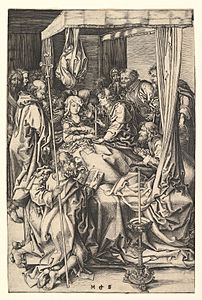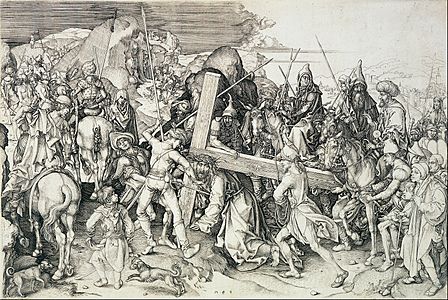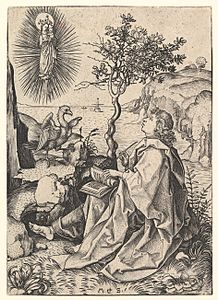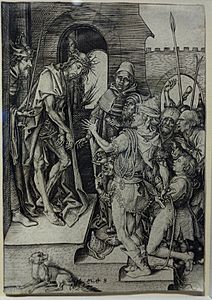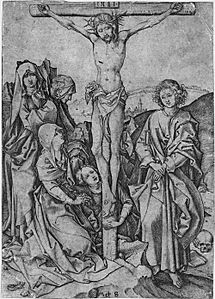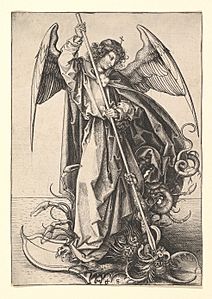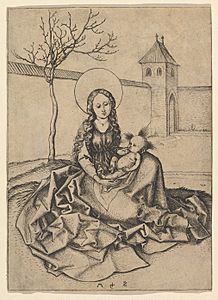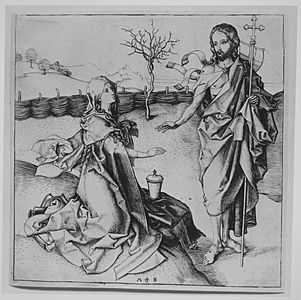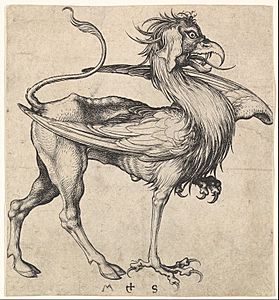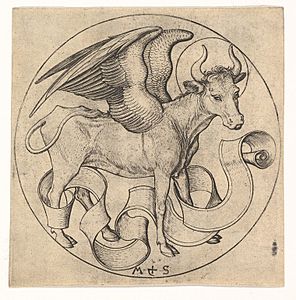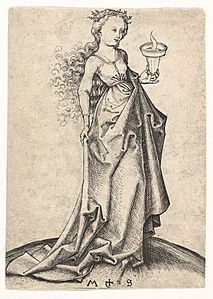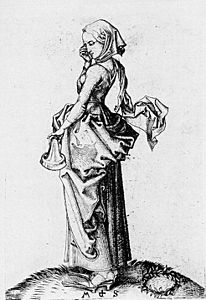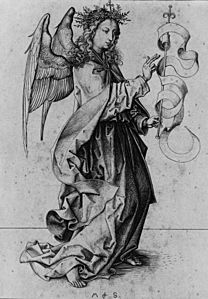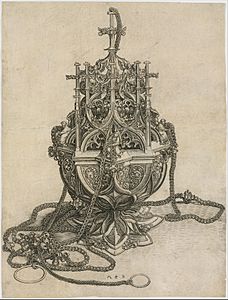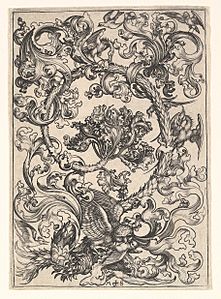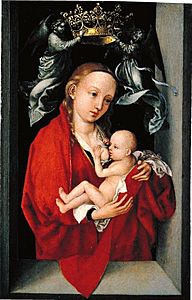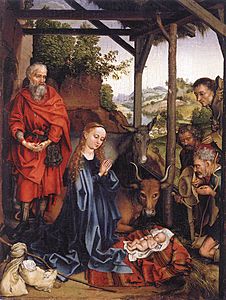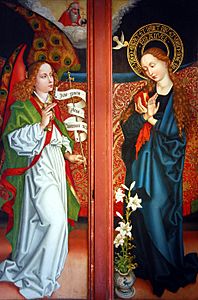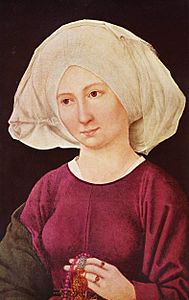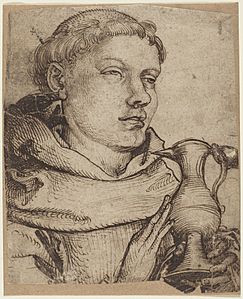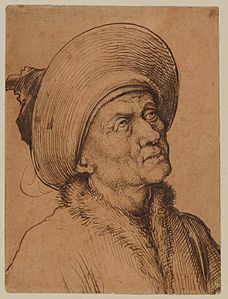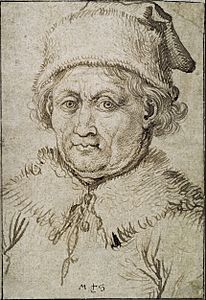Martin Schongauer facts for kids
Martin Schongauer (born around 1450–1453 in Colmar, died 1491 in Breisach) was a very important artist from a region called Alsace. People at the time sometimes called him "Martin the Beautiful" or "Pretty Martin." He was a skilled engraver and painter.
Before Albrecht Dürer came along, Schongauer was the most famous printmaker north of the Alps. Dürer, who was younger, even collected Schongauer's art! Schongauer was the first German painter to also be a major engraver. He likely learned engraving from his family, who were goldsmiths.
Schongauer made 116 engravings that we know of. All of them have his special mark, called a monogram, but none have dates. His prints were popular not just in Germany, but also in Italy, England, and Spain. A famous artist named Michelangelo even copied one of Schongauer's engravings! Schongauer's art style was a clear and organized form of Gothic art. It was influenced by both German and Dutch art.
Many other artists copied his engravings, which was common back then. A busy artist named Israhel van Meckenem copied exactly half of Schongauer's engravings! Schongauer also made some beautiful drawings and a few paintings using oil and fresco techniques.
About Martin Schongauer's Life
Martin Schongauer was born in Colmar, Alsace, between 1450 and 1453. He was one of several sons of Caspar Schongauer, a goldsmith who had moved to Colmar. Caspar became a master goldsmith in 1445. It's likely that Martin learned engraving from his father, as goldsmiths often used this skill. Two of Martin's brothers also became goldsmiths, and another became a painter. Colmar is now in France, but back then it was part of the Holy Roman Empire and spoke German.
Unusually for an artist of his time, Martin went to university. He started at the University of Leipzig in 1465, probably when he was around 12 or 13. He seems to have left after only a year. For a long time, people thought he learned engraving from another artist called Master E. S.. However, experts now doubt this. Schongauer's engraving skills developed over time, which suggests he didn't learn everything from one teacher.
He probably trained as a painter with Caspar Isenmann, a main artist in Colmar. Isenmann was influenced by Dutch painters like Rogier van der Weyden. Schongauer's few surviving paintings show this influence. He likely trained between 1466 and 1469. He was back in Colmar by 1469. His older brother, Ludwig Schongauer, might have trained there before him.
Schongauer's early engravings also show clear influences from Dutch painters. This suggests he traveled after his training, which was a common practice called a wanderjahre. One drawing from 1469 is a copy of Christ from Rogier van der Weyden's Beaune Altarpiece. Some details in his art, like costumes and exotic plants, make some experts think he might have visited Spain or Portugal.
He returned to Colmar and opened his own workshop by 1471. He received payments for an altarpiece for the Dominican church there. This altarpiece is now in a museum and is thought to be made by his workshop. His painting Madonna in the Rose Garden is dated 1473. It's his only dated painting and matches the style of his earliest engravings.
It's not clear how artists made money from prints in the 1400s. Even though his prints made him famous across Europe, he might have earned more from his main job as a painter.
Schongauer died in Breisach in 1491, possibly before he turned 40. Since 1488, he had been working on a huge painting called Last Judgment in the cathedral there. This was the biggest mural painting north of the Alps, but it was not finished when he died.
The next year, Albrecht Dürer traveled to Colmar to meet Schongauer. Dürer was on his own wanderjahre (traveling period). But Dürer found out that Schongauer had already passed away. Dürer admired Schongauer and collected his drawings and prints. Dürer even included the same two exotic trees from Schongauer's Flight into Egypt in his own print, as a tribute. In Germany, Dürer became the next great artist after Schongauer.
One of Schongauer's students was Hans Burgkmair the Elder. He was a painter and designed woodcuts. He studied with Schongauer from 1488 to 1490. A painted portrait of Schongauer, now in Munich, was likely made after his death. It might be a copy of an earlier drawing or painting. It's thought to be by Hans Burgkmair the Elder.
Other engravers who copied Schongauer's work or had a similar style are also thought to have been his students.
Schongauer's Engravings
One hundred and sixteen engravings are generally believed to be made by Schongauer himself. Many of his students' prints, as well as his own, are signed with his special mark, M†S. He probably started signing his engravings in the early 1470s. His prints are quite rare, but it's thought that examples of all the engravings he made still exist today.
Most of his engravings show religious scenes. However, he also made a few funny pictures of everyday life. These include "Peasant Family Going to Market" and "Two Apprentices Fighting." He even made a print of an elephant! An elephant was actually touring Germany in 1483.
Schongauer also created nine of the first ornament prints. These were meant to be used by craftsmen, like woodcarvers and goldsmiths. They provided patterns for fancy designs. He also made two prints of metal objects, a censer (for burning incense) and a crosier (a bishop's staff).
Schongauer came from a family of goldsmiths and went to university. This meant he knew the growing group of merchants and professionals who bought high-quality engravings. However, his work does not include subjects from classical mythology, which were popular in Italian prints at the time.
His engravings show how his technique improved over time. His early works were often very detailed and crowded, but still well-organized. Later, his compositions became simpler, with more empty space. Some of his busy early prints were the most popular and influential. These include The Temptation of St Anthony and Christ Carrying the Cross.
He made several series of engravings that show his artistic growth. These include the "Passion" series (about 12 scenes), the "Twelve Apostles," and the "Wise and Foolish Virgins." In his last prints, like the "Annunciation," the background is very simple.
Schongauer improved on earlier engraving techniques. He used a system called cross-hatching, which means drawing lines in two directions to show volume. Albrecht Dürer later developed this even further. Schongauer was also the first engraver to curve parallel lines. He also found a way to make deeper lines on the plate. This meant more prints could be made before the plate wore out.
According to art historian Arthur Mayger Hind, Schongauer was one of the first German engravers to go beyond the limits of Gothic art. He created a sense of beauty that appealed to many people.
Along with Master E.S., Schongauer was the first northern printmaker whose designs were widely copied. Not only by other printmakers, but also by painters, sculptors, and artists using all kinds of materials. The strange demons in his The Temptation of St Anthony influenced artists like Hieronymus Bosch.
Many major art museums have good collections of Schongauer's prints. Most of his prints are fairly common for art from the 1400s. However, the quality of the prints can vary a lot. The different watermarks found suggest that prints were made over a long time. Many were made when the copper plates were already showing signs of wear. For example, about sixty copies of Rest on the Flight into Egypt exist, but only seven are considered "first quality." For the large Christ Carrying the Cross, about seventy copies exist, with fifteen of them being top quality.
- Engravings
Schongauer's Paintings
Only a few of Schongauer's paintings have survived. The most famous is the Madonna in the Rose Garden. It was painted for St Martin's Church, Colmar and is now in a nearby Dominican church. This painting shows a German subject, but Schongauer painted it in a style very similar to Dutch art. The painting has been cut down to fit its fancy carved frame.
The Musée d´Unterlinden in Colmar has the largest collection of his paintings. It includes two panels from the "Orlier Altarpiece," painted around 1470–1475. These panels show the Annunciation on the outside and a Nativity scene on the inside. Experts believe Schongauer largely painted these himself. There are also 24 panels from an altarpiece for the Dominican church. These were mostly painted by his workshop, following his designs. A painting called Nativity in Berlin is also believed to be by him.
The small painting Holy Family in the Kunsthistorisches Museum in Vienna looks very much like his engravings. It's not much bigger than some of his prints. Many everyday details in the painting, like the grapes and wheat, have special meanings related to the religious subject. This was a common practice in Dutch painting.
A watercolour and gouache drawing of paeony leaves and flowers was found in 1988. It's now in the Getty Museum. This drawing is related to the flowers in the Madonna in the Rose Garden painting.
The large fresco paintings in the Breisach cathedral are still there. However, they are in very poor condition.
- Paintings and drawings
See also
 In Spanish: Martin Schongauer para niños
In Spanish: Martin Schongauer para niños


